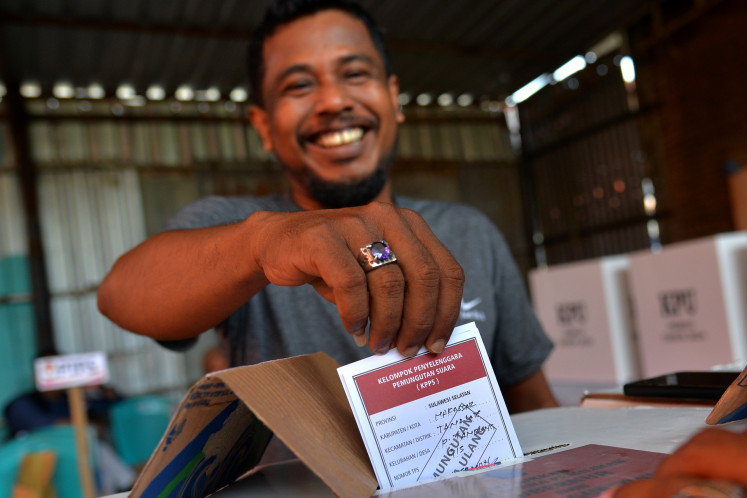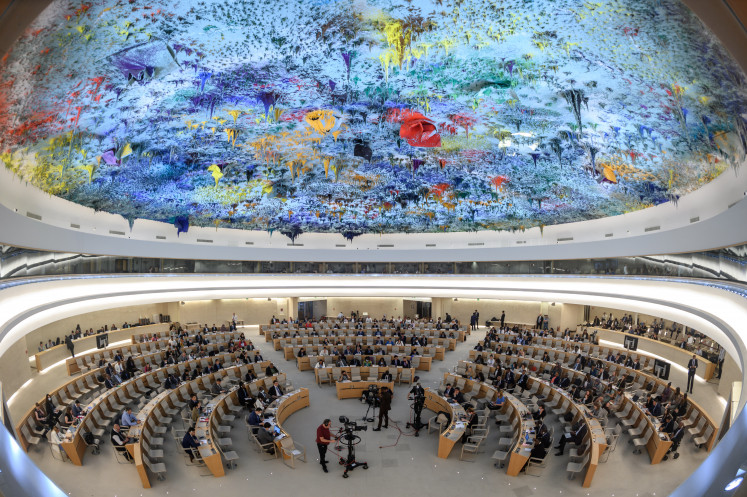Popular Reads
Top Results
Can't find what you're looking for?
View all search resultsPopular Reads
Top Results
Can't find what you're looking for?
View all search resultsNo hype: APEC economies on resilient growth path
As a result of Indonesia’s integration into the global trading system, exporters are enjoying greater access to markets and consumers in the world’s 16th largest economy, thanks to higher growth rates, are hungrier for a larger variety of imported products
Change text size
Gift Premium Articles
to Anyone
A
s a result of Indonesia’s integration into the global trading system, exporters are enjoying greater access to markets and consumers in the world’s 16th largest economy, thanks to higher growth rates, are hungrier for a larger variety of imported products.
Economic growth in the archipelago has exceeded 5 percent in eight of the last nine years and is predicted to rise to 6.3 percent in 2013, according to the World Bank. This is up from just over six percent in 2012.
The rest of the Asia-Pacific is, in general, experiencing an upward growth trajectory. Growth slowed in the region during much of 2012, but it has already begun to regain ground.
Encouragingly, the markets are currently seeing 2013 as the year when a wider range of economies return to more robust growth.
APEC member economies, guided by Indonesia this year, are taking steps in this direction as we advance our agenda to revive growth and deliver greater opportunity to more people.
Moving toward free and open trade and investment in the region by 2020 is a top priority. This is especially fitting considering that APEC leaders embarked on this commitment, known as “the Bogor Goals”, here in Indonesia nearly two decades ago to achieve sustainable growth, equitable development and strengthen the sense of community of the Asia-Pacific.
Considerable progress has been made possible by APEC members’ increasing integration, resistance to protectionism and joint work to liberalize and facilitate trade and investment.
Average tariffs in the region were reduced from about 17 percent when APEC was founded in 1989 to 5.7 percent in 2011.
Though there is still more to be done, APEC members have also reduced or eliminated some non-tariff measures such as import licenses and quotas.
As a result, APEC economies’ total trade increased 6.4 times to US$19.7 trillion between 1989 and 2011, outpacing the rest of the world. What’s more, members are two times more likely to import from a fellow member than a non-member. Similarly, they are three times more likely to export to a fellow member than a non-member.
Growth in APEC economies’ foreign direct investment (FDI) is also on the rise. In 2012, FDI in Indonesia rose more than 25 percent and is forecast to remain around this level in 2013, according to the Indonesia Investment Coordinating Board.
This progress is helping Indonesia achieve high growth rates. It is also delivering important tangible benefits at a grassroots level by creating new employment opportunities, increasing wages and raising living standards for Indonesia’s expanding middle class.
Sustaining this momentum is critical and prompting APEC economies to pursue further results-oriented policy. Among others, this includes a commitment to reduce tariffs to 5 percent or less on a significant number of environmental goods by the end of 2015, reducing red tape to help achieve a 25 percent improvement in the region’s business environment by 2015, and resisting measures inconsistent with WTO commitments.
APEC furthermore recognizes that growth as usual cannot continue and that the quality of growth must be improved. APEC leaders came to this conclusion in Yokohama, Japan in 2010 and, in turn, launched the APEC Growth Strategy to help ensure that regional growth and economic integration are sustainable and widely shared by the people.
Members are working toward implementing this strategy, with emphasis on the promotion of inclusive growth that allows equity and social justice to flourish. On the one hand, this involves empowering the creativity of the region by expanding access to the resources necessary for success in today’s 21st century global economy.
In particular, members are advancing policies that help local firms internationalize, support women’s entrepreneurship and promote innovation in areas such as green technology that can be transformed into new business opportunities. Improving credit worthiness, access to financial services and risk protection are among other issues that members are addressing to help micro, small and medium enterprises in particular which account for most of Indonesia’s businesses and employment.
The daily needs of workers and their families must also be guaranteed to maximize the region’s productivity.
To safeguard food production and access, APEC economies, together with the private sector, are exploring ways to boost technical cooperation and investment in agriculture. This is critical to feeding Indonesia’s nearly 250 million people.
It is also vital to upgrading its agricultural sector which accounts for about 15 percent of gross domestic product and supports the livelihoods of tens of millions of farmers.
APEC economies are meanwhile working to ensure a healthy, productive labor force overall through the exchange of best practices and preventative treatment strategies.
More active participation in the APEC regional economy is essential to increasing sustainable growth but it requires infrastructure that brings markets, businesses and individuals together.
Boosting physical connectivity is among our focuses. Members are, for example, now in discussions to design a framework to promote infrastructure development and investment.
This is crucial for developing economies whose distant provinces and growth centers are in many cases still inadequately linked to road, air and water-based transportation networks, as well as for developed economies who are increasingly confronted with the need to upgrade aging infrastructure.
It moreover compliments Indonesia’s plan to invest over US$200 billion in infrastructure spending through 2014.
Other supply chain chokepoints such as regulatory impediments and customs inefficiencies are also commanding considerable attention. The goal for APEC economies is to realize a 10 percent improvement in supply chain performance by 2015, in terms of reducing the time, cost and uncertainty of moving goods and services through the region.
At the same time, members are enhancing institutional connectivity in the region, particularly in the higher education sector to strengthen innovation and business development. Emphasis is on identifying regulatory best practices, improving researcher, student and educator mobility, and bolstering cross-border education services and instructional delivery.
APEC is furthermore enhancing people-to-people connectivity. Facilitating travel for emergency responders is an important focal point given that the Asia-Pacific is home to over 70 percent of the world’s natural disasters.
Specifically, APEC economies are sharing effective disaster relief procedures, improving customs and immigration data sharing and advancing an emergency responder travel facilitation action plan. The goal is to mitigate the economic and social impact of disasters such as the January floods here in Jakarta as well as earthquakes, tsunamis, landslides and volcanic events that affect Indonesia more broadly.
Without doubt, 2013 will present its fair share of challenges for the APEC region. But by pushing ahead with the APEC agenda, Indonesia and other member economies will stand a much better chance of keeping on a sustainable growth path to bring greater stability to the global economy.
The writer is executive director, APEC Secretariat










